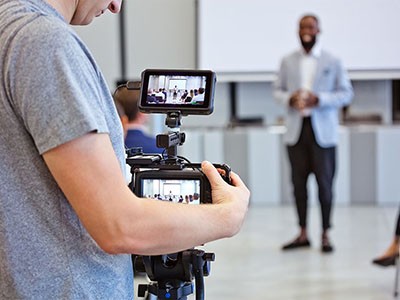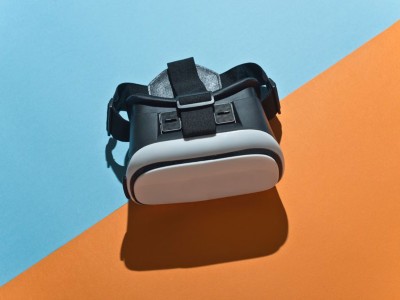
Women at in-person meetings tend to ask fewer questions than do men, studies have shown.Credit: Getty
A concern that women ask fewer questions than men at both in-person and virtual conferences is an issue that Hanna Julienne and her colleagues highlight at the regular ‘feminist cafes’ they hold to discuss gender and diversity issues in science.
Julienne, a statistical geneticist at the Pasteur Institute in Paris, says that most of her female colleagues agree that post-talk Q&As often turn into a “question-and-manswer” session.
To test that hypothesis, Julienne and two of her colleagues undertook an observational study1 of JOBIM, a French bioinformatics conference held online over four days in June 2021. The latest version of their analysis was posted on the preprint server bioRxiv in October.
Previous studies of in-person meetings have shown that women ask fewer questions than do men — but there has been little research on virtual conferences, says Julienne.
How to banish manels and manferences from scientific meetings
The bioinformatics conference had an almost equal ratio of male and female attendees (52% of those aged under 45 were women) and was skewed towards the younger age group, with 62% of the 695 registered participants under the age of 35.
Despite this seeming to be an event at which women might feel at ease because of the gender balance and relative youth of attendees, the researchers found the Q&A sessions were dominated by men. Of the 192 written questions posted in a chat thread during the conference, 57 were asked by women, 115 by men and 20 by people who identified as ‘anonymous’ or belonging to a group. For spoken questions, the effect was similar: of the 257 questions asked across the 66 talks at JOBIM, 78 — or fewer than one-third — were posed by women.
“Seniority compounds the effects,” says Julienne. “We found that a senior man (someone aged over 35) would, on average, ask 9.3 more questions than a junior woman, while a senior woman would ask just 2.3 more questions than a junior man.”
Question time
A total of 144 people filled in questionnaires sent after the conference. The researchers also undertook in-depth, follow-up interviews with seven participants — a representative sample of male and female junior and senior attendees, those identifying as members of a sexual or gender minority (LGBTQIA+), foreign female attendees and those who asked three or more questions during the conference.
There were no clear-cut reasons for why women asked fewer questions. Instead, Julienne says, their analysis found that deep-seated issues of gender discrimination and bias were at play.
Science diversified: The men who say no to manels
In the interviews, women talked about the gender discrimination and harassment they had experienced throughout their careers, which they said had affected their self-confidence, meaning they were less comfortable speaking up. But most had never made a link between this and their willingness to ask questions, the study found1.
Anthropologist Junhanlu Zhang, who conducted the interviews during a 2021 postgraduate research internship at the Pasteur Institute, says that even the senior female academics expressed these feelings.
Zhang is now an impact analyst at the European Synchrotron Radiation Facility in Grenoble, France, and manages mixed-method research projects that mitigate societal challenges. “I thought someone who has a certain seniority and who has been in an institution for a long time would have the confidence that I look forward to gaining in future,” she says. “But that’s not always the case. The interviewee could still be quite self-conscious, have a lack of confidence and refer back to her negative experiences as a student or during her PhD.”
Simple fixes
However, conference organizers can take some simple steps to encourage women to speak up. For instance, says Julienne: “We found that the longer the Q&A session was, the more likely women were to ask questions.”
A 2018 analysis of women’s visibility in academic seminars2 recommended other ways to prompt more questions from women. These include allowing a junior female academic to pose the first question, and having a short break between the talk and Q&A, which allows attendees to formulate a question and try it out on a colleague first.
The right mix: making a hybrid conference work for all
Representation is important, says Zhang, and question-asking can help to raise a scientist’s profile. Their study1 found that attendees were more likely to remember the names of the “serial” question-askers — usually men — who made three or more interventions during the conference.
“When you give your opinion or ask a question at a conference, more people recognize you. Asking questions also reflects your interest, so people might come up to you at the social event afterwards,” Zhang says.
Although the virtual conference did not result in more women asking questions than at in-person meetings, holding events online can help to increase the number of female attendees, says Julienne. She points out that the 2021 meeting was the first ever JOBIM conference to have equal numbers of male and female registrants. “Mothers find them easier to attend, for example, and they are more affordable,” she says.
Gillian Sandstrom, who researches the psychology of kindness at the University of Sussex near Brighton, UK, has looked at question-asking after academic seminars2,3. She says she was not surprised that results were similar for both online and in-person events.
“Even when you’re asking questions online, it’s not anonymous. I remember attending an online lecture series, and people would ask a question before the talk had barely started. They like to get their name in there,” she adds.
Different approaches
Sandstrom and her colleagues have also investigated whether men and women ask questions differently, and if this somehow affects a willingness to speak up: for instance, women might fear a negative backlash because of how they express themselves.
What’s on the agenda for post-pandemic meetings?
Their study3, posted on the preprint server PsyArXiv last month, looked at how often the questioner complimented the speaker on their talk, and whether they introduced themselves and greeted the speaker before asking their question. The researchers also assessed how often words expressing doubt and uncertainty came up, such as “confused”, “probably” and “unsure”.
“We found that women were more likely than men to greet the speaker, but in every other respect there was no difference,” she said. Although the reasons for not posing a question might be murky, it is an issue that needs to be highlighted, says Sandstrom.
“People aren’t aware that there is this gender disparity, and so that does seem actionable. One of the most rewarding things for me personally was when I talked about our recent paper. One of the students came up to me afterwards and said how much it made him think about his own behaviour,” she adds.
Julienne says her research has made her more proactive. “I’m a little introverted, but I do try and ask more questions now.”





